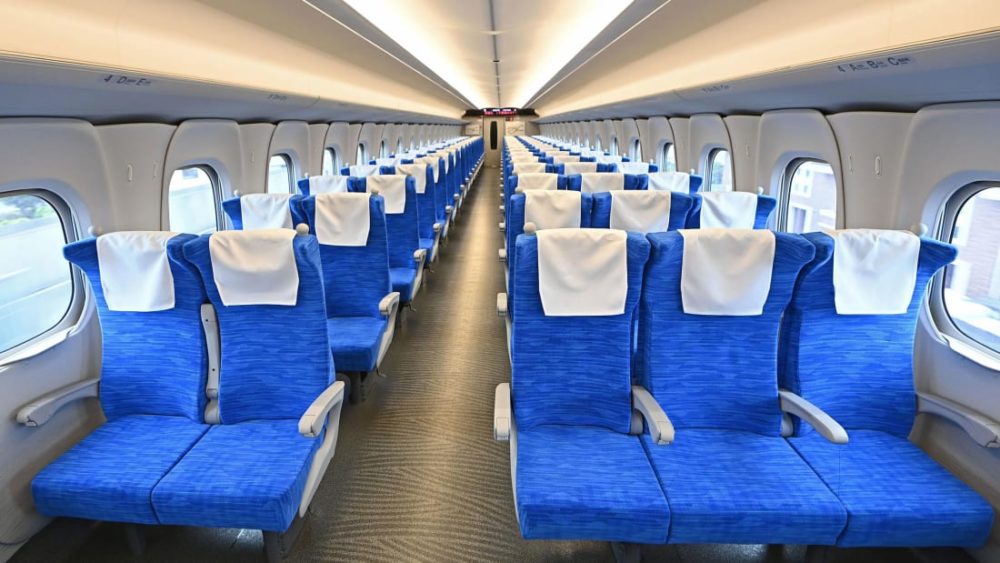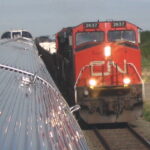Falling Farther Behind.
The Japanese have just introduced a new generation of high speed trains.

It’s been put into service on the Tokyo-Osaka run and has a top speed of 360 km/hour. That translates to 223 miles/hour. However, the new trains won’t run at top speed. They’ll throttle back to a mere 177 mph. Still, the faster they go, the behinder we get. What I cannot understand are the people who still stubbornly and stridently insist that high-speed trains won’t be successful here . . . reminding me of the old expression, “If you can’t be right, be wrong at the top of your voice.”



Those looking to get somewhere fast will not take a 175mph train which doesn’t yet exist. They will take a 500mph airplane that already exists along with all of the associated infrastructure. Imagine the cost of a dedicated high speed right-of-way Chicago to Seattle. This bullet-Empire Builder would serve what purpose? To connect Minnesota, N. Dakota and Montana hinterlands? If you stopped at all the small towns on this route your average speed would wind up around 100mph, if that. And if you don’t stop at any to the intermediate cities, who does the train serve? The train that already exists runs half-empty 9 months of the year. It is basically a summer tourist train.
As Mr Frodsham points out, “rail buffs” want a slow speed train. A fancy restaurant and hotel on wheels with white glove service. And that’s great for the wealthy retirees I see on these routes, but its not part of a modern transportation system. It is nostalgia. And don’t expect Republicans OR Democrats to fund a project such as that.
No one is suggesting a 187 m.p.h. Empire Builder. But we are suggesting a combination of high speed trains operating in high density corridors (Boston-New York-Washington or perhaps Cincinnati-Colmbus-Cleveland) and more trains running a conventional speeds to provide affordable public transportation for as many people as possible throughout the rest of the country. It’s an approach to public transportation that has been proven successful for 50 years in Japan. China built thousands of miles of a high-speed system in less that 20 years. And you can travel from Paris to almost any city and most towns throughout Europe within one 12-hour day using a combination of conventional and high-speed trains. With respect, this argument was over several decades ago. The real question is why is it taking the U.S. so long to do want is so obviously right for our transportation needs.
But I don’t want a high speed train. I want a slow speed train to give me more time to enjoy the journey, and to enjoy a meal in the diner will full dining service before I retire to my sleeper compartment.
You need to understand that these delights of passenger rail were thoroughly and vividly described in the book “All Aboard: The Complete North American Train Travel Guide.
Ah, yes … I would anticipate that the system would evolve the way it has in Europe: fast trains on shorter, busier routes (London-Paris) with fast-food type dining; slower trains on longer routes (Berlin-Moscow) with full service dining and lounge cars, and sleeping accommodations.
European, here. We don’t use trains to travel the width of the continent, either (well, some exceptions exist, I’m one of them, but we are exceptions), they use the train for relative short hops of perhaps 1-3 hours, mostly. High speed rail expands the range you can cover in that time, changing the game. Where most went by plane between Barcelona and Madrid, few still do. Same for say Amsterdam-Paris, or Milan-Rome. True long-distance trains have suffered immensely, and few remain, even if they see a moderate resurgence, now.
Because it’s not only time flying, it’s time getting to the airport (which is rarely near your departure or destination), the whole security and check-in hassle, etc which should be considered, and trains here don’t score that bad. Even if a train ride might be slightly longer, it’s uninterrupted you-time, unlike flying which may be half an hour drive to the airport, half an hour getting through security, less then an hour in the air and again a half hour to your final destination. I’ll take a 3-hour train ride over that mess anytime.
With the exception of the most ecologically minded activists, most rail advocates are not against flying as such, but think flying is not suited for short trips. And they are not alone, there’s a reason why the chairman of Amsterdam Airport advocates for more (high-speed) trains, they free up much-needed capacity at airports for more long-distance by getting rid of most local flights, and when airports have a high-speed train station, by bringing more customers to them (assuming their business model doesn’t rely mainly on parking fees, of course.)
Yes, this can’t be directly translated to a North-American context, but few are advocating for a transcontinental high-speed network. The conditions which exist in most of (Western) Europe exist in some regions, LA-San Francisco, the Canadian ‘Corridor’, the Texas Triangle, the NEC, etc. The most frequent flight connection in the US is LA-SF, if even part of that demand could be met by rail, a lot of slots could be freed up for intercontinental flights with better margins.